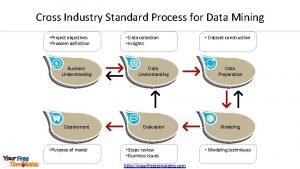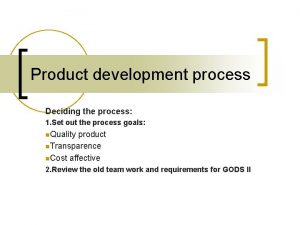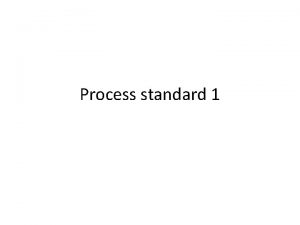Inaport Training Standard Matching Matching Process of deciding


















- Slides: 18

Inaport Training Standard Matching

Matching • Process of deciding which record or set of records in the target table(s) should be updated • Alternatively, decide if record already exists and take appropriate action © Copyright 2010 Ina. Plex Inc

Matching Techniques Inaport supports different ways to match • Standard • build expressions on source and target • Fuzzy • Refine Standard to allow for bad data • SQL • Use SQL SELECT instead of expressions © Copyright 2010 Ina. Plex Inc

Standard Matching Easiest, most flexible of the techniques • Can match on ANY field or combination of fields • Can apply expressions for incoming and/or target records independently • Source: normcomp(#My. Company) • Target: normcomp((#Account) • Use AND / OR to provide complicated matches © Copyright 2010 Ina. Plex Inc

How it Works For each table with Standard matching • Read the match fields • Build an in memory index for each table • The target match expression is applied to the field data read from the table • As each record comes in • The source match expression is applied to the record • The resulting value is found in the in memory index • If necessary, in memory index is updated after changes are applied to database © Copyright 2010 Ina. Plex Inc

Matching Example Import leads to Company - Person Company • Match on name, phone area code Person • Match on first & last name © Copyright 2010 Ina. Plex Inc

Select Match Type On the Operation Tab, select “Standard Matching” © Copyright 2010 Ina. Plex Inc

Company Relationships Only need primary key as this is top table © Copyright 2010 Ina. Plex Inc

Company Match Tab Build expressions on source side and target side • E. g. name and phone number area code • Using normcomp() function to normalise company name. This will lower case, equalise spaces, remove noise words • Remember – results will be compared exactly © Copyright 2010 Ina. Plex Inc

Company Map Tab Need to make sure all fields used in matching are mapped when creating records In memory indexes will be updated © Copyright 2010 Ina. Plex Inc

Matching – Parent/Child Two parts • Table relationships • Specify primary/foreign keys using data dictionary, expression editor • Primary key from parent used to find related records in child • Match expressions • Further refine matches on tables AFTER relationships have been used © Copyright 2007 Ina. Plex Limited

Person Relationships As the Person table is a child of Company, need to specify the foreign key that relates child table to parent Inaport will normally fill in automatically © Copyright 2010 Ina. Plex Inc

Person Match tab Matching on first and last name • E. g. Concatenate names, then normalise © Copyright 2010 Ina. Plex Inc

Person Map Tab As with Company, it is important to ensure that match fields are also mapped, or indexes may not be updated correctly © Copyright 2010 Ina. Plex Inc

Benefits Easy to understand Works across all target systems Very flexible matching • • • Can use any combination of fields Can use simple or complex expressions for either source or target Can do “OR” matching – specify multiple different match criteria, match on any High speed for moderate data sets • 200, 000 – 400, 000 records © Copyright 2010 Ina. Plex Inc

Drawbacks • Can be slow for large (>400, 000) data sets • Up front cost of building indexes – Inaport has to read data from target and build the index • Memory cost of indexes – Large indexes can consume a lot of memory • Ultimately, is an exact match criteria • Can use expressions such as norm() • Consider Fuzzy Matching if issue © Copyright 2010 Ina. Plex Inc

Summary Standard Matching is powerful, flexible and easy to understand For dirty data, consider Fuzzy Matching For large data sets, consider SQL Matching Remember • You can mix and match – use different match techniques on different tables © Copyright 2010 Ina. Plex Inc

THANK YOU www. inaplex. com/cs/forums © Copyright 2007 Ina. Plex Limited
 Inaport
Inaport Deciding to marry asl story
Deciding to marry asl story Batasan perencanaan
Batasan perencanaan Planning is deciding in advance what is to be done
Planning is deciding in advance what is to be done Deciding on the global marketing organization
Deciding on the global marketing organization What is this image
What is this image In the tiff between scout and calpurnia
In the tiff between scout and calpurnia Invoice matching
Invoice matching Std error
Std error What language you speak at home
What language you speak at home Standard cost
Standard cost Dskp
Dskp Standard work training exercise
Standard work training exercise Standard training program
Standard training program Lsw leader standard work
Lsw leader standard work Training is expensive without training it is more expensive
Training is expensive without training it is more expensive Perbedaan on the job training dan off the job training
Perbedaan on the job training dan off the job training Aggression replacement training facilitator training
Aggression replacement training facilitator training Cross industry process for data mining
Cross industry process for data mining


































